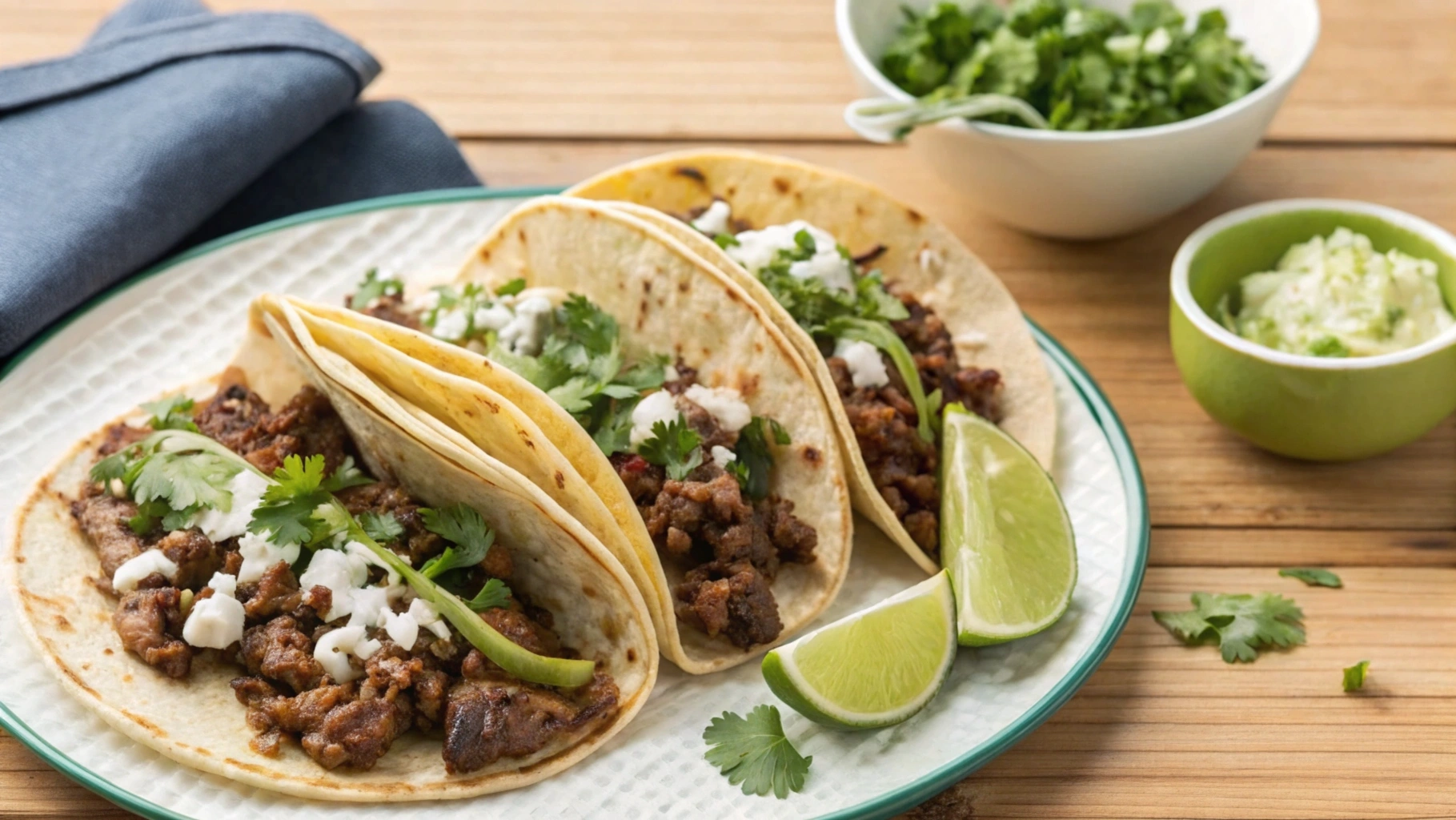Have you ever tasted something so unique it stays with you? That’s what Tacos de Lengua are all about. They’re a key part of Mexican street food. Every time I think of Mexico’s lively taquerias, I remember the first bite of a soft tortilla with tender beef tongue, fresh onions, and zesty salsa verde.
Table of contents
These flavors capture the true spirit of Mexican cuisine. They bring the tradition and warmth of Mexican streets right to your table.
Tacos de Lengua Recipe is more than just a dish; it’s a deep connection to culture and heritage. It shows how our ancestors made the most of every piece of meat. Braising the beef tongue for hours with garlic, cumin, and oregano is a tradition that’s been passed down for generations.
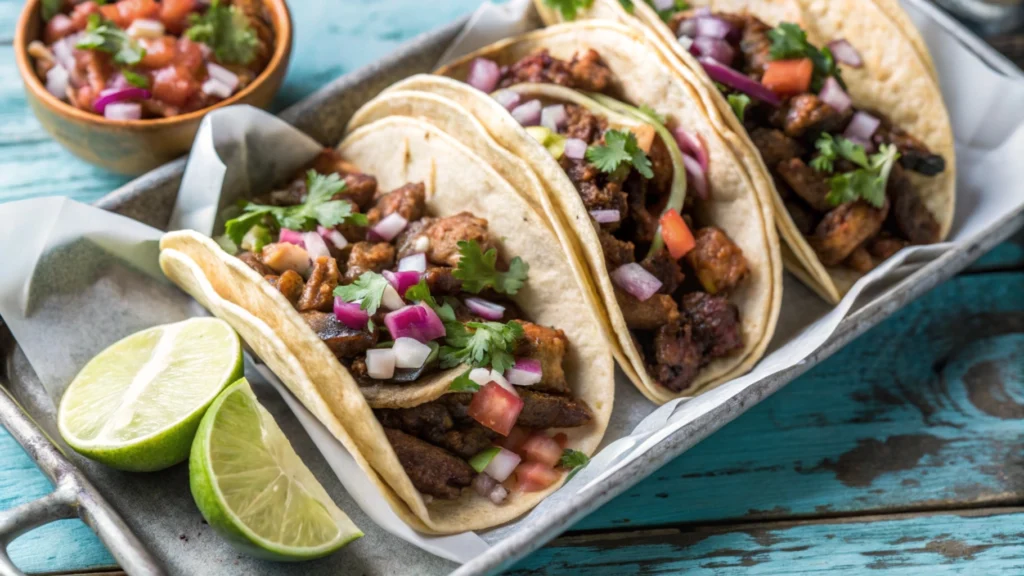
Key Takeaways
- Tacos de Lengua offer a unique and memorable culinary experience as part of Mexican street food culture.
- This dish emphasizes using less commonly-consumed cuts of meat, showcasing the resourcefulness of authentic Mexican cuisine.
- Beef tongue tacos are deeply rooted in cultural heritage, popular in Mexico and among Hispanic communities in the USA.
- The preparation process involves slow-cooking the beef tongue with traditional spices for a tender and flavorful result.
- These tacos are typically served with corn tortillas, salsa verde, onions, and crumbled cotija cheese, providing a full sensory experience.
What Are Tacos de Lengua?
Tacos de lengua, or beef tongue tacos, are a favorite in Mexico. They turn a less common meat into a delicious treat. The slow cooking makes the meat very tender.
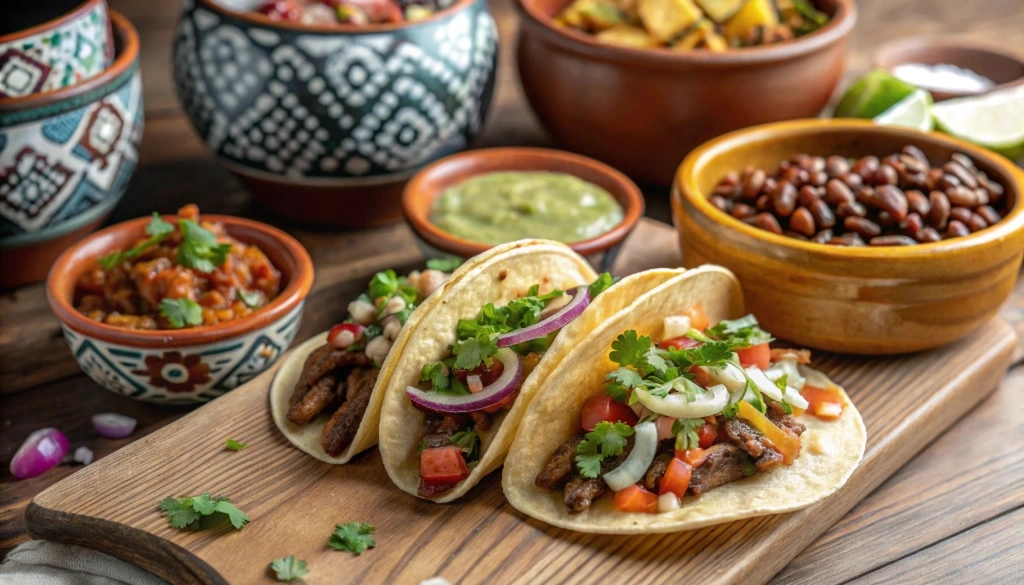
Making tacos de lengua is an art in Mexican cooking. It starts with boiling the tongue with spices and herbs. After hours of cooking, the tongue is skinned, diced, and seared for extra flavor.
This Tacos de Lengua Recipe is simple and perfect for feeding a crowd, yielding 15 servings. It requires just 15 minutes of preparation and 2 hours and 30 minutes of cooking time. For a hands-off approach, you can cook it on high for 9 hours.
These tacos are served on small corn tortillas with onion, cilantro, and lime. Many say they are the best tacos they’ve ever had. They are so popular that taco shops often sell out quickly.
For a real taco experience, look for places that serve traditional fillings like beef tongue. This way, you can taste the true flavors of Mexican cuisine.
How to Prepare Tacos de Lengua
Making tacos de lengua requires a few steps to make the cow tongue tender and tasty. This guide will show you the ingredients, the cooking process, and tips to make this dish perfectly. We’ll use traditional Mexican cooking methods.
Ingredients Needed
- 3 to 4 pounds of beef tongue
- 2 bay leaves
- 12 to 24 corn tortillas (2 to 3 per person)
- 6 stems of cilantro
- 1 medium onion, chopped
- 1 small carrot, chopped
- 2 cloves of garlic
- Salt, pepper to taste
- Chili powder, cumin, oregano
- Bottled or canned salsa verde
- Optional garnishes: avocado, red onion, chopped onions, fresh cilantro, thinly sliced radishes, lime wedges
- Duck fat, pork fat, or canola oil for frying
These ingredients will give your tacos a balanced and authentic taste.
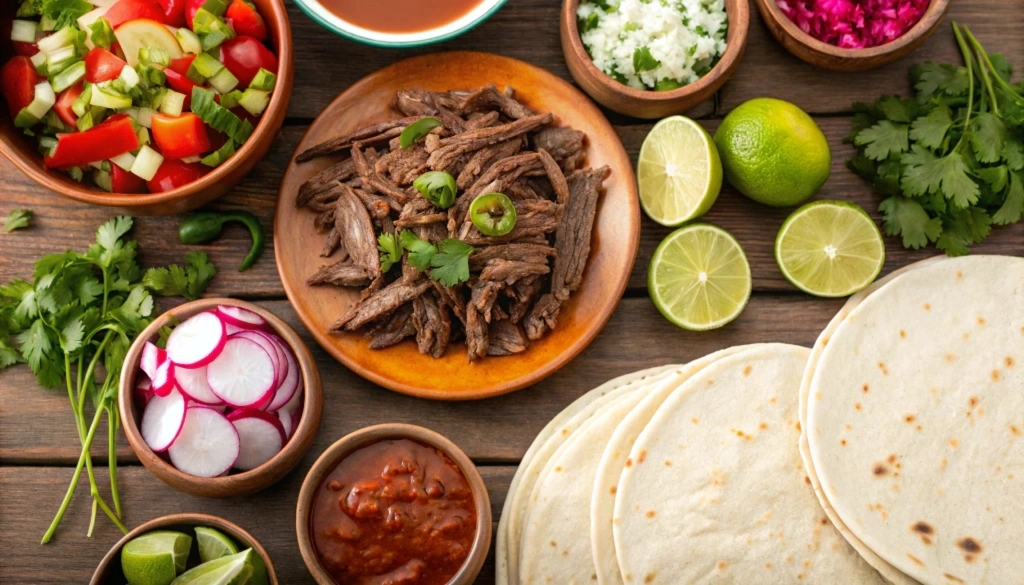
Step-by-Step Cooking Instructions
- Prep the tongue: Clean the beef tongue well and put it in a big pot. Add onion, carrot, garlic, bay leaves, cilantro stems, and salt. Cover it with water and boil.
- Simmer until tender: Lower the heat and let it simmer for 4 to 6 hours. Make sure it reaches 160ºF. This step is key to making the tongue tender.
- Remove the outer skin: After cooking, remove the tongue from the pot and peel off the tough skin. It’s easier when it’s still warm.
- Slice and cube: Cut the tongue into thin slices and then into small cubes. Fry them in a skillet with duck fat or canola oil until crispy.
- Warm the tortillas: Warm the corn tortillas on a skillet or griddle until they’re soft and pliable.
- Assemble and serve: Put a lot of the cooked tongue on each tortilla. Add your favorite toppings like avocado, fresh salsa, and lime wedges.
Tips for Perfect Tacos de Lengua
- For the best flavor, marinate the boiled tongue slices in spices before frying them.
- Make sure the cow tongue is tender before slicing. This avoids a chewy texture in the final dish.
- Use fresh, quality ingredients for toppings to add a refreshing contrast to the savory filling.
- Planning ahead can save time. You can prepare the beef tongue up to 5 days in advance and store it in an airtight container in the fridge.
For more simple and flavorful recipes, along with practical kitchen tips, check out Morsel Recipes.
Health Benefits and Nutritional Value of Tacos de Lengua
The Tacos de Lengua Recipe delivers a delicious and nutrient-rich Mexican dish. With high protein, essential vitamins, and minerals, it’s a flavorful choice for a balanced diet. Let’s uncover its health benefits and enjoy these tasty tacos.
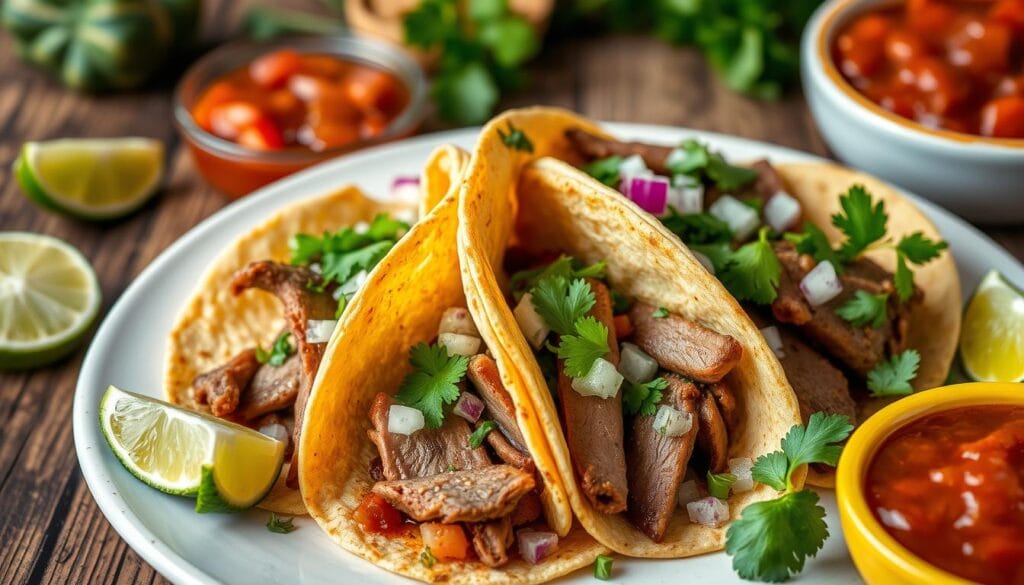
Protein Content
A 3-ounce serving of simmered beef tongue contains 16 grams of protein, fulfilling 27% of the daily protein needs for a 165-pound individual. Protein supports muscle repair, hormone production, and overall body maintenance, making Tacos de Lengua Recipe an excellent option for those seeking a high-protein, nutritious Mexican dish.
Vitamins and Minerals
Tacos de Lengua is rich in essential vitamins and minerals. It greatly boosts your nutritional intake:
- Vitamin B12: Each 3-ounce serving has 2.7 micrograms, covering the daily need of 2.4 micrograms (112% DV).
- Iron: It offers 2.2 milligrams, which is 28% of daily iron needs for men and 12% for women.
- Zinc: A 3-ounce portion has 3.5 milligrams, meeting 44% of the daily recommended intake for women and 32% for men.
Balancing Tacos de Lengua in Your Diet
To include Tacos de Lengua in a healthy diet, follow some balanced diet tips. Since each serving has 19 grams of total fat, including 6.9 grams of saturated fat, manage portion sizes and skim off excess fat. Pair these tacos with various vegetables and whole grains to boost their nutritional value without increasing saturated fat.
| Nutrient | Amount per 3-oz Serving | % Daily Value |
|---|---|---|
| Calories | 241 | – |
| Total Fat | 19g | – |
| Saturated Fat | 6.9g | – |
| Cholesterol | 112mg | 37% |
| Sodium | 55mg | – |
| Protein | 16g | – |
| Vitamin B6 | – | 7% |
| Vitamin B12 | 2.7mcg | 44% |
| Zinc | 3.5mg | 23% |
| Iron | 2.2mg | 12% |
The Cultural Significance of Tacos de Lengua
The Tacos de Lengua Recipe, or beef tongue tacos, is a cornerstone of Mexican cuisine. It embodies the tradition of utilizing every part of the animal, showcasing respect for resources and connecting us to our ancestral culinary practices.
In Mexico, tacos de lengua is key to a taquería’s authenticity. People say a taquería without this dish isn’t true. These tacos are more than food; they mark important family and community events.
Mexican food is rich and varied, shaped by history and region. For example, in Guerrero and Michoacán, similar dishes are called burrito and burro. This shows Mexico’s diverse cuisine.
Tacos de lengua’s history goes back to indigenous times. It shows how Mexican dishes blend old traditions with new influences. In places like Jalisco, the tequila capital, blue agave fields add to Mexico’s culinary beauty.
Tacos de lengua are not just tasty; they bring people together. They connect us to our heritage at celebrations and family gatherings. This feeling is shared by Chef Ava, which helps users explore new flavors and recipes.
So, when you enjoy a taco de lengua, you’re part of a long story. It’s filled with the spirit of Mexican traditions and rich cultural memories.
FAQs
How long should I boil the cow tongue for Tacos de Lengua?
Boiling the cow tongue until it’s tender can take a few hours. This step is key to making the tongue soft and easy to slice for your Tacos de Lengua.
How do I know when the cow tongue is tender enough to slice?
The tongue is ready to slice when you can easily pierce it with a fork. It should be soft but not fall apart.
What spices are best for marinating boiled tongue slices?
A mix of garlic, cumin, paprika, and chili powder can enhance the flavor. You can adjust these spices to your liking.
How do I peel the outer skin of the cow tongue?
After boiling, let the tongue cool slightly. Then, peel off the outer skin. The skin should come off easily, revealing the tender meat beneath.
How can I make my Tacos de Lengua crispy?
To get a crispy texture, sauté the boiled and sliced tongue strips in a skillet with a bit of oil. Cook them until they are browned and crispy.
What are some traditional toppings for Tacos de Lengua?
Traditional toppings include onions, cilantro, and your choice of salsa. Adding a squeeze of lime juice can also add freshness.
Are Tacos de Lengua nutritious?
Yes, Tacos de Lengua are rich in vitamins B12, iron, zinc, and selenium. These nutrients are important for red blood cell formation, immune system health, and thyroid function.
How can I balance Tacos de Lengua in my diet?
To keep Tacos de Lengua balanced, manage portion sizes and pair them with vegetables and whole grains. Choosing lean cuts and skimming off excess fat also helps.
What is the cultural significance of Tacos de Lengua?
Tacos de Lengua have a special place in Mexican culinary traditions. They are often enjoyed at festive occasions and family gatherings. They showcase the resourcefulness and creativity in traditional Mexican cuisine.
Conclusion
Tacos de Lengua offer a unique taste experience in Mexican cuisine. They start with a 3-4 pound beef tongue, simmered for 2.5 to 3 hours. This makes the meat tender and ready for toppings.
Essential toppings include diced tomatoes, onions, cilantro, and lime. These add flavor to the dish. The recipe guides you through making these tacos, ensuring a delicious result.
Adding your own seasonings can make each taco special. This shows the diversity and richness of Mexican cuisine. Tacos de Lengua highlight the tradition of using all parts of the animal.
Choosing the right toppings is key to enhancing your tacos. Avocado, cheese, salsa, and radishes are great options. Pairing them with drinks like horchata or tamarind can make the meal even better.
Remember, tacos de lengua are more than food. They celebrate cultural heritage and culinary skill. Exploring these dishes is a journey into the heart of Mexican cuisine.
